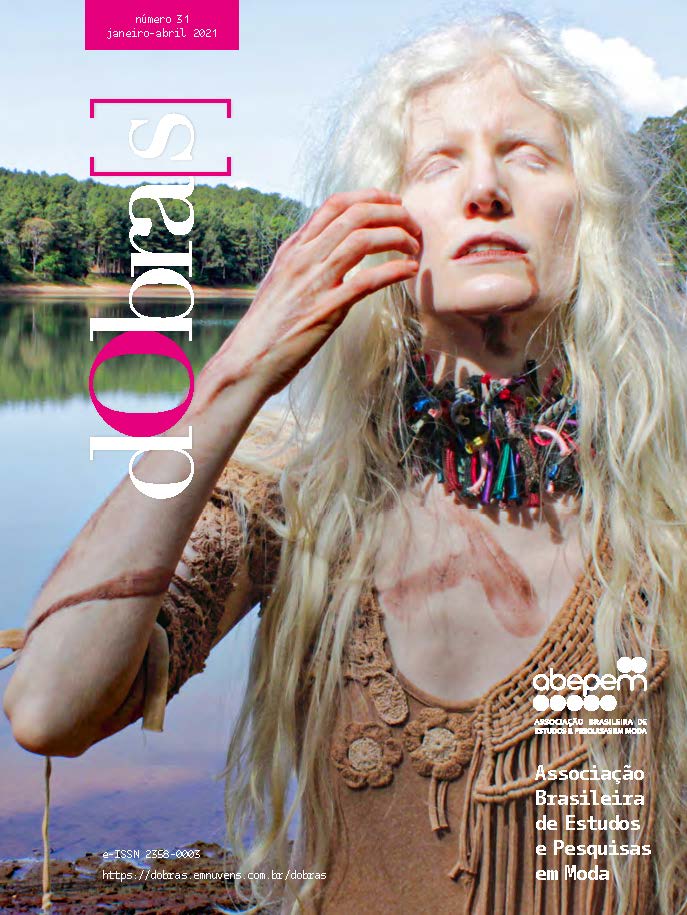300 anos de corpos e corsets em suas manifestações rítmicas
por uma semiótica da moda
DOI:
https://doi.org/10.26563/dobras.i31.1286Palabras clave:
Corset, Feminine body, Western fashion, Visual semiotics, Socio-semioticsResumen
The article reflects on a research project analysing 300 years of the practice ofconstraining the feminine torso, aiming at presenting the theories supporting the investigationto expose how their intersection and articulation could become a method for analysing fashionobjects. Stemming from the semiotics works concerned with the plastic of objects, mainlythe theories proposed by Greimas and further developed by Floch and Oliveira, we present anaddress of Fashion beyond its visual dimension, exploring the manners in which the relationsbetween the body and its dress are problems of discourse and narrative interactions, returningto Greimas’ Standard Semiotics and Landowski’s Socio-semiotics. The combination of theoriespresented in this piece was used to examine a corpus of feminine apparatuses utilised to reshapea woman’s silhouette throughout history, from the 18th century to the present, such ascorsets and crinolines, as well as various other types of shapewear, in combination with theanalysis of supporting texts, such as Artworks, literary works, pieces of popular culture andadvertisement. The work presents the steps of the investigation taking place between 2012and 2014 – the selection of the corpus and its analysis – and the future developments stemmingfrom that first exam, bringing about a reconstruction of the work and its results as a methodologicproposition that can serve the analysis of sartorial objects but is equally pertinent to theanalysis of any other manifestation that is subjected to rhythmic changes.
Descargas
Citas
BAUDELAIRE, Charles. The painter of modern life. London: Phaidon, 1964.
BOUCHER, François. História do vestuário no Ocidente. São Paulo: Cosac Naify, 2010.
BRAGA, João. História da moda: uma narrativa. São Paulo: Anhembi Morumbi, 2004.
FLOCH, Jean-Marie. Petites mythologies de l’oeil et de l’esprit. Paris, Amsterdam: Hadès-Benjamins, 1985.
GREIMAS, Algirdas-Julien. Du sens. Paris: Seuil, 1970.
GREIMAS, Algirdas-Julien. Semiótica e ciências sociais. São Paulo: Cultrix, 1976.
GREIMAS, Algirdas-Julien. Du sens II. Paris: Seuil, 1983.
GREIMAS, Algirdas-Julien. Sémiotique figurative et sémiotique plastique. Actes Sémiotiques, v. VI, n. 60, 1984, p. 3-24.
GREIMAS, Algirdas-Julien. Sémantique structurale. Paris: PUF, 1986.
GREIMAS, Algirdas-Julien. La mode en 1830. Paris: PUF, 2000.
GREIMAS, Algirdas-Julien. Da imperfeição. Trad. Ana Claudia de Oliveira. São Paulo: Hacker, 2002.
GREIMAS, Algirdas-Julien; COURTÉS, Joseph. Dictionnaire raisonné de la théorie du langage. Paris: Hachette, 1993.
HAMMAD, Manar. Expression spatiale de l’énonciation. Cruzeiro Semiótico, n. 5, 1986, p. 38-79.
HART, Avril; NORTH, Susan. Seventeenth and eighteenth-century fashion in detail. London: V&A, 1998.
HJELMSLEV, Louis. Prolégomènes à une théorie du langage. Paris: Minuit, 1966.
JARDIM, Marilia. O corset na moda ocidental. 2014. 226 f. Dissertação (Mestrado em Comunicação e Semiótica) – Programa de Pós-Graduação em Comunicação e Semiótica, PUC-SP, São Paulo, 2014.
JARDIM, Marilia. The corset and the veil as disruptive manifestations of clothing: the tightlacer and the Tuareg. Revista dObra[s], v. 12, n. 25, 2019, p. 53-74.
JARDIM, Marilia. The corset and the hijab. Absence and presence in the 19th and 20thcentury fashion system. Actes Sémiotiques, n. 123, 2020. Available at: https://www.unilim.fr/actes-semiotiques/6415. Acess in: 18th of March 2021
JOHNSTON, Lucy. Nineteenth-century fashion in detail. London: V&A, 2005.
KUNZLE, David. Fashion and fetishism: corsets, tight-lacing & other forms of bodysculpture. Stroud: Sutton, 2004.
LANDOWSKI, Eric. A Sociedade refletida. São Paulo: EDUC/Pontes, 1992.
LANDOWSKI, Eric. Présences de l’autre. Paris: PUF, 1997.
LANDOWSKI, Eric. Passions sans nom. Paris: PUF, 2004.
LANDOWSKI, Eric. Les interactions risquées. Limoges: PULIM, 2005.
LANDOWSKI, Eric. Avoir prise, donner prise. Actes Sémiotiques, n. 112, 2009, available at: https://www.unilim.fr/actes-semiotiques/2852. Acess in: 18th of March 2021
LANDOWSKi, Eric. Régimes d’espace. Actes Sémiotiques, n. 113, 2010, available at: https://www.unilim.fr/actes-semiotiques/1743. Access in: 18th of March 2021
LYNN, Eleri. Underwear fashion in detail. London: V&A, 2010.
OLIVEIRA, Ana Claudia. Semiótica plástica. São Paulo: Hacker, 2004.
OLIVEIRA, Ana Claudia. Visualidade processual da aparência. In: OLIVEIRA, Ana Claudia; CASTILHO, Kathia (eds). Corpo e moda: Por uma compreensão do contemporâneo. São Paulo: Estação das Letras e Cores, 2008, p. 93-104.
SAUSSURE, Ferdinand. Cours de linguistique générale. Paris: Payot, 1922.
STEELE, Valerie. Fetish: fashion, sex and power. Oxford: Oxford University Press, 1997.
STEELE, Valerie. The corset: A cultural history. New Haven & London: Yale University Press, 2001.
STEVENSON, Angus (org). Oxford Dictionary of English. Oxford: Oxford University Press, 2010.










